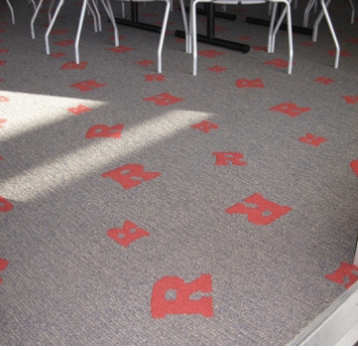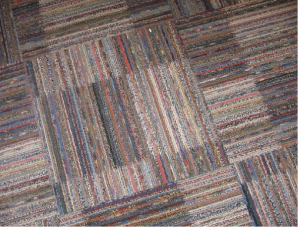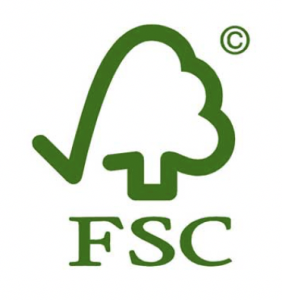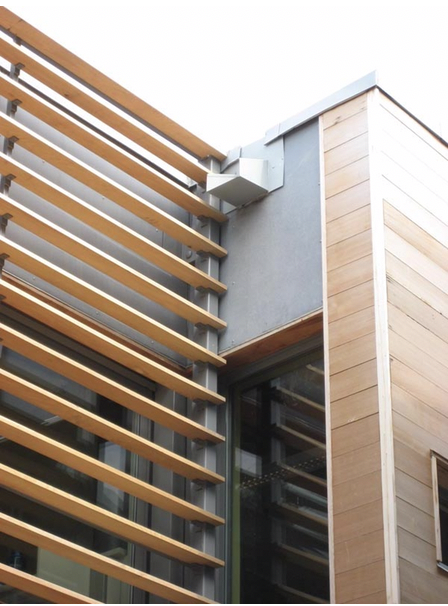Sustainable Materials
New CommercialWhat are Sustainable Materials?
Sustainable materials provide environmental and human health benefits and reduce negative impacts over the life of the material and generally incorporate characteristics that contribute to:[1]
- Resource efficiency & conservation
- Indoor air quality
- Energy efficiency
- Affordability
- Safe and healthy indoor environments
- Durability and adaptability
There are environmental impacts throughout the life cycle of a material (extracting resources, processing, producing, shipping, installation and use, and discarding). Evaluating and understanding the health and environmental impacts of materials is complex and can be confusing, but good resources and increased availability of product information can help.[2]

Figure 1 – Recycled carpet (Source: Rutgers University)
How to Integrate Sustainable Materials
Sustainable material management (SMM) refers to the process of researching the system-wide impacts of the life cycle of materials.[3] A comprehensive approach that incorporates social, environmental, and economic factors relies on the use of research, innovation, and technology to support decisions about appropriate material selection and use.[4] Environmental Product Declarations (EPD) provide information about the environmental impact of a material throughout its life cycle. LEEDv4 rewards project teams for incorporating materials and products that have life cycle information available and verified positive environmental life cycle impacts.[5]
When choosing materials, consider the following aspects of sustainability:
- Recycled content and recyclability
- Certified wood (such as Forest Stewardship Council-certified products)
- Locally produced and sourced products
- Rapidly renewable materials
- Salvaged materials
- Non-toxic, no/low-emitting materials
- Durability and adaptability
When developing material specifications and standards for a project, it is important to consider environmental factors such as waste prevention and disposal (see Construction and Demolition Waste Reduction, Demolition, and Source Reduction and Recycling).[6] It is also essential to develop an environmentally preferable purchasing policy to guide purchasing. According to documents guiding federal sustainability (Executive Order 13693), environmentally preferable purchasing refers to “products or services that have a lesser or reduced effect on human health and the environment when compared with competing products or services that serve the same purpose” as it applies to raw materials, manufacturing, packaging, distribution, use, reuse, operation, maintenance, and disposal.[7]
The US EPA website has several useful tools for finding and evaluating green products and services.[8] There are a number of certification programs, standards and criteria available to help provide guidance in selecting and evaluating sustainable materials such as GREENGUARD (indoor air quality certification), Green Label Plus (carpets/rugs), Green Seal, Scientific Certification Systems, Rainforest Alliance Certification, and Forest Stewardship Council Certification. Also, life cycle assessment tools such as those offered by the Athena Sustainable Materials Institute are useful in helping to assess the cost and impact of a material. Cradle to Cradle is a third-party certification for products that promote safety for humans, the environment, and are designed for future life cycles rather than being disposed.[9]
Recycled Content & Recyclability
Using recycled materials reduces the amount of waste that ends up in landfills or incinerators and reduces the extraction of resources used to produce new products and materials. Many common building materials and furnishings contain recycled materials such as asphalt, steel, carpet, ceiling tiles, and concrete. Post-consumer recycled content is material that has been used by consumers, collected and re-manufactured into new products and materials. Plastic lumber is a product that often has high post-consumer recycled content. Some plastic lumber is composed of 100% post-consumer plastic such as milk jugs and laundry detergent bottles.
Labeling related to recycled content can be confusing. The recycling symbol is in the public domain, so its use can have a variety of meanings. Some products have labeling that identifies the percentage of pre-consumer and/or post-consumer recycled content in the product. If a product is not labeled, contact the manufacturer and ask about recycled content.

Figure 2 – Carpet made from recycled fibers (Source: Flickr http://www.flickr.com/photos/erindowney/278614807/)
Typical materials that often contain post-consumer recycled content include:[10]
- Drywall
- Insulation
- Plastic lumber
- Kitchen countertops
- Glass tiles
- Landscaping materials
- Carpet and carpet padding
- Steel
The recyclability of materials is also an essential consideration in materials selection. Some materials are recyclable at the end of their useful life into new high-quality carpeting with very little waste such as carpet products that are Cradle to Cradle (C2C) certified.[11]
Certified Wood
Certified wood refers to wood harvested from forests that practice environmentally and economically responsible forestry. A third-party entity documents the sustainable forestry practices and the chain of custody, which tracks wood from the forest through milling and manufacturing to the point of sale. Certifiers also grant chain-of-custody certifications to companies that manufacture and sell products made from certified wood. Forest certification intends to let consumers know that wood or paper product comes from forests managed under strict environmental and social standards. The Forest Resource Certification Center provides information about several well-known certification programs.

FSC Certified Logo
The Forest Stewardship Council (FSC) is one example of a popular certification program. FSC has established a program that monitors third-party certifiers of forests and forest products. During FSC forest-management assessments, teams of foresters, ecologists and social scientists visit forestry operations and inspect their practices for compliance with FSC’s standards, such as:
- Ensuring harvesting rates and clearing sizes do not exceed a forest’s natural capacity to regenerate
- Maintaining natural forest conditions needed for wildlife and healthy ecosystem function
- Protecting rare, threatened and endangered species and forest types
- Establishing new plantations on agricultural and pasture lands and avoiding the replacement of natural forests with barren tree plantations
- Creating adequate conservation zones
- Minimizing or eliminating chemical use
- Protecting streams and rivers from soil erosion that degrades water quality and fish habitat
- Protecting the rights and interests of workers, communities, and indigenous people who benefit from the forestry operation
Forestry operations that meet the standards are granted an FSC forest management certification and audited annually. Forestry operations are required to make improvements as a condition of getting certified and staying certified over time.[12]
During the design stages of a building, specify certified wood as an alternative to conventional wood including certified plywood and veneers. There are several resources available to assist with finding certified wood such as the FSC Certificate Database. This database includes primarily manufacturers and distributors, not retailers. To find products carried by a local retailer, contact them directly.[13] Look for the FSC logo (Figure 3) stamped on the product. In addition to choosing certified wood, selecting salvaged or reclaimed wood also helps protect resources and reduce waste. Purchase wood from local producers when possible to reduce CO2 emissions from transporting the materials.

Figure 4 – The siding (right side of image) of the Queens Botanical Garden’s Visitor Center is FSC certified Western Red Cedar (Source: Queens Botanical Garden/Nicole De Feo)
Locally Produced and Sourced Products
The LEED system includes a location valuation factor that promotes the use of products extracted, manufactured and purchased within 100 miles of a project. Purchasing locally produced products helps support local businesses and reduce transportation-related environmental impacts.[14]
Salvaged Materials
Salvaged materials include materials saved during the deconstruction process and sold, donated, stored for later use, or reused on future projects (see Deconstruction). Construction and Demolition (C&D) debris accounts for 534 million tons of waste, 90% the result of demolition work with the remaining 10% generated by construction activities.[15] Carefully dismantling a structure with the intent of reusing materials extends the useful life materials, requires less energy and raw materials, and produces less pollution than discarding or recycling materials.
Identify materials to reuse, sell, donate, or recycle early in the planning process and develop a plan for salvaged materials in project documents such as the construction and demolition waste management plan (see Construction and Demolition Waste Reduction).[16] Salvageable materials may include plumbing, light fixtures, doors, cabinets, working appliances, windows, millwork, carpet, brick, ceiling and floor tiles, wood, HVAC equipment, and decorative items such as fireplaces and stonework.[17] When reusing salvaged materials, keep in mind that materials may contain chemicals not safe for the environment and human health. The EPA’s Best Practices for Reducing, Reusing, and Recycling Construction and Demolition Materials site has information on potentially contaminated materials and substances.[18],[19]
Contact organizations and programs that facilitate the exchange or purchase of salvaged or surplus building materials. Other options include auctions and classified websites designed to sell, donate or buy materials. Check with a consulting a site such as The Better Business Bureau Wise Giving Alliance to identify organizations eligible to receive donations.
Rapidly Renewable Resources
Rapidly renewable materials are natural, non-petroleum-based building materials and include agricultural by-products such as bamboo, straw, cork, natural linoleum products, cotton, sunflowers, hemp, wool, wheatboard, and strawboard. Using materials produced with rapidly growing plant-based products reduces the harvesting of forests and other resources that take decades to regenerate. Consider green building materials comprised of a composite of rapidly renewable materials and recycled content (e.g., newsprint, cotton, soy-based materials, seed husks).[20] Compare the environmental trade-offs of using a product such as global warming, resource depletion, indoor air quality.[21] Although some materials might be from rapidly renewable sources, they may require shipping from long distances or may not be as durable as other conventional materials.
Example
An adaptive reuse project at the Barn at Fallingwater in Mill Run, Pennsylvania used the original characteristics of the barn and provided new space for administrative offices, exhibitions, lectures, classes, and programs. Along with furthering the connection between nature and architecture, the project earned a Silver LEED rating. This adaptive reuse project also incorporated several renewable resources such as straw panels for sound absorptive wall finishes and products from sunflower seed composite.

Figure 5 – Barn at Fallingwater (Source: Fallingwater.org)
Non-toxic, No/low-emitting Materials
Safe, non-toxic or low-emitting materials release relatively low levels of odorous, irritating, toxic, or hazardous substances unhealthy to building occupants.[22] Volatile organic compounds (VOCs) (including formaldehyde), particulates, and fibers include substances often emitted from building materials that can adversely impact human health.
VOCs contain carbon molecules and can vaporize from material surfaces into indoor air at average room temperatures (a process known as off-gassing).[23] A non-toxic material must meet different thresholds of VOC emissions compliance depending on the material.[24] Found in many everyday products and building materials, VOCs can escape into the air and cause illness and allergic reactions. Studies have linked elevated levels of VOCs and interior pollutants to health concerns that cause eye, nose and throat irritation, headaches, loss of coordination, nausea, and other health problems. [25] People with respiratory problems, children, seniors and people with compromised immune systems are at higher risk of reactions from exposure than the general population.
Increased awareness about possible health risks and indoor air quality concerns have helped to expand the market for safe, non-toxic materials. Low-emitting material credit requirements by LEED and other green building certifications have led to a demand for products lower in VOCs and toxic chemicals.[26] Several certification programs, standards, and criteria for selecting and evaluating sustainable materials include GREENGUARD (indoor air quality certification), Green Label Plus (carpets/rugs), Green Seal, and Scientific Certification Systems (see Safe, Non-Toxic Materials).
Durable Materials and Designing for Adaptability
Selecting durable and adaptable materials reduces waste, extends the useful life of a building and contributes to the resiliency of the structure.[27] Durable materials require less repair and less frequent replacement so the environmental impacts of the resources that have been invested in those materials can be spread out over a longer time.[28] A durability plan can help inform decision making throughout every phase of a building’s development and addresses factors such as sunlight, moisture, heat, insects, and natural disasters.[29] Designing for adaptability allows materials to be easily disassembled and reused, thus providing economic benefits and reducing environmental impacts.[30]
Benefits
Careful selection and use of sustainable materials provide environmental benefits in many ways such as:
- Conserving resources
- Reducing greenhouse gas emissions (in extraction, production, and shipping)
- Supporting local businesses and economy
- Ensuring safer air quality indoor (also overall regional air quality)
Consumer demand for sustainable materials and product certification is a powerful incentive for manufacturers and suppliers. By purchasing certified wood, for example, forest managers are more likely to adopt ecologically sound practices that maintain natural forest characteristics. Also, demand can help to move the wood industry away from destructive techniques like large-scale clearcutting, logging in endangered and old growth forests, and destruction of natural forests for replacement by barren tree plantations.[31]
Choosing certified and/or salvaged wood and wood products can help:
- Protect natural forests and other habitats
- Reduce the use of highly hazardous pesticides
- Minimize the cultivation of genetically modified trees (GMOs)
- Protect the rights of indigenous peoples
Using post-consumer recycled content:[32]
- Reduces waste going into landfills and incinerators
- Preserves natural resources by reducing the use of virgin materials used to produce new products and materials
- Saves energy and prevents pollution caused by the extraction and processing of virgin materials and the manufacture of products using virgin materials
- Contributes to the recycling economy
Using rapidly renewable materials can:
- Reduce the use and depletion of finite raw materials
- Reduce the number and quantity of products made from fossil-fuel derivatives
- Reduce demand for materials that require longer to regenerate
Salvaging materials during the demolition process shift the construction industry away from the conventional practice of consumption and disposal towards an ethic of resource efficiency and reuse. The benefits of using salvaged materials include:[33]
- Minimizing landfill waste and pollution and the need for more landfills
- Decreasing consumption and demand for new materials, reducing waste and pollution associated with the production of virgin materials
- Creating value-added markets from waste materials
- Expanding job opportunities and workforce development skills
- Reducing project costs through avoided disposal costs and purchases of new materials, revenue earned from material sales, and tax breaks gained for donations
- Preserving architectural and cultural heritage by salvaging unique materials
The selection of building material and furnishings have a significant impact on indoor environmental quality. Benefits of choosing low-emitting materials include: [34]
- Improved indoor air quality.
- Improved worker safety and health.
- Reduced incidents of an eye and respiratory irritation, headaches, fatigue.
- Healthier environment for building occupants who are sensitive to specific products.
- Reduced pollution of groundwater and water supplies.
Costs
There is a perception that sustainable products always cost more than conventional products. Some materials do have a higher first cost; however, the first cost is often made up within the overall life cycle cost of the material. Life Cycle Cost Analysis (LCCA) (see Life Cycle Cost Analysis) takes into account the lifecycle costs of building designs and systems while a Life Cycle Assessment (LCA) (see Life Cycle Assessment) evaluates the environmental impacts of products, services, and systems.[35] Together, LCCA’s and LCA’s provide the essential components of a comprehensive cost-benefit analysis. There are also many sustainable materials available that are comparable in price to conventional materials.[36] Low- and no-VOC paints typically cost about the same as a manufacturer’s premium line of paints.[37] Furthermore, non-sustainable materials often do not reflect the costs (often referred to as “externalities”), such as expenses associated with cleaning up contamination and losses due to human health and illness.
As a result of increased demand and changes in technology, post-consumer recycled products are readily available on the market today and are often comparable in cost and quality to products made with virgin materials. The price for recycled content padding and carpeting, for example, is often comparable to a conventional, virgin-fiber carpet.[38] Whether virgin or recycled, many factors impact the cost of products such as availability, cost of material feedstocks, energy costs, distributor mark-up, transportation charges, size and type of order, and geographic location. The cost-effectiveness of reusing, donating or selling salvaged building materials varies with each project, depending on the value of the salvaged materials, the market for these materials, and the costs of labor and disposal. Post-consumer recycled products may last longer or require less maintenance than their counterparts made with virgin material which can offset any additional up-front costs. Therefore, items with high wear and tear, maintenance or replacement frequency may be ideal candidates for post-consumer recycled products with higher upfront costs, but longer useful life expectancy.
Resiliency
Many of the benefits listed above also contribute to resiliency. Selecting sustainable materials can help protect human health by minimizing exposure to toxic components during an emergency and contributing to the durability of the facility and its contents. Protecting indoor air quality contributes to building occupants’ health and well-being and the ability of the occupants to function during and recover from disruption. Using sustainable materials, such as certified or salvaged wood can help protect natural habitats that contribute to more resilient ecosystems. Established networks and markets for salvaged materials also help divert and reuse debris generated by natural disasters and severe storm events that can contaminate the environment following storm surges, flooding, and high winds.[39] Salvaging materials from storms turn recovery efforts into a profit-generating resource rather than a post-disaster clean-up expense.
The use of safe, non-toxic materials in building assemblies and furnishings can help reduce the release of toxic chemicals into debris following storm surges, flooding, and high winds caused by natural disasters and severe storm events. For example, Superstorm Sandy generated over 8 million cubic yards of debris across the nine hardest-hit counties in New Jersey in only one day.[40] Damaged and contaminated materials may include waterlogged drywall, plaster, insulation, flooring, carpets, mattresses, and upholstered furniture, that when put it into unlined landfills, can contaminate groundwater.
Using moisture protective and inherent moisture-wicking materials, as well as materials resistant to excessive humidity such as glazed brick, concrete, stone, and decay-resistant lumber can also contribute to more resilient structures.
[1] CalRecycle. https://www.calrecycle.ca.gov/Greenbuilding/Materials/ (accessed February 1, 2019)).
[2] Whole Building Design Guide. Evaluating and Selecting Green Products. http://www.wbdg.org/resources/evaluating-and-selecting-green-products (accessed February 1, 2019).
[3] US EPA. Sustainable Materials Management. The Road Ahead. https://www.epa.gov/smm/sustainable-materials-management-road-ahead (accessed November 28, 2018).
[4] BIAC. The Voice of OECD Business. Key Business Messages. Sustainable Materials Management. http://www.oecd.org/dataoecd/35/18/46235661.pdf (accessed November 28, 2018).
[5] USGBC. Building Product Disclosure and Optimization – environmental product declarations. https://www.usgbc.org/credits/new-construction-core-and-shell-schools-new-construction-retail-new-construction-healthca-22 (accessed February 1, 2019).
[6] Whole Building Design Guide. Optimize Building Space and Material Use. http://www.wbdg.org/design-objectives/sustainable/optimize-building-space-material-use (accessed February 19, 2019).
[7] US EPA. About the Environmentally Preferable Purchasing Program. https://www.epa.gov/greenerproducts/about-environmentally-preferable-purchasing-program (accessed February 3, 2019).
[8] Whole Building Design Guide. 2016. Evaluating and Selecting Green Products. http://www.wbdg.org/resources/evaluating-and-selecting-green-products (accessed February 19, 2019).
[9] Whole Building Design Guide. 2016. Evaluating and Selecting Green Products. http://www.wbdg.org/resources/evaluating-and-selecting-green-products (accessed February 19, 2019).
[10] Cal Recycle. Matrix: Overview of Recycled Content and Availability. https://www.calrecycle.ca.gov/greenbuilding/materials/matrix (accessed February 19, 2019).
[11] The Cradle to CradleÒ program certifies products that meet multi-attribute criteria for: human and environmental health; Recyclability/compostability; renewable energy use; water stewardship social responsibility.
[12] Natural Resources Defense Council. http://www.nrdc.org/land/forests/qcert.asp (accessed February 19, 2019).
[13] Forest Stewardship Council. https://us.fsc.org/en-us (accessed February 19, 2019).
[14] USGBC. LEEDv4. https://www.usgbc.org/guide/bdc (accessed February 1, 2019).
[15] US EPA. Advancing Sustainable Materials Management: 2014 Fact Sheet. November 2016
https://www.epa.gov/sites/production/files/2016-11/documents/2014_smmfactsheet_508.pdf (accessed June 23, 2018) (As cited in US EPA. Sustainable Management of Construction and Demolition Materials. February 2018. (https://www.epa.gov/smm/sustainable-management-construction-and-demolition-materials)
[16] US EPA. Best Practices for Reducing, Reusing, and Recycling Construction and Demolition Materials. Aug 23, 2017. https://www.epa.gov/smm/best-practices-reducing-reusing-and-recycling-construction-and-demolition-materials (accessed July 2, 2018)
[17] Habitat for Humanity. Habitat ReStore. “8 things to donate when renovating.”
https://www.habitat.org/stories/8-things-to-donate-when-renovating (accessed July 13, 2018).
[18] US EPA. Best Practices for Reducing, Reusing, and Recycling Construction and Demolition Materials. Aug 23, 2017. https://www.epa.gov/smm/best-practices-reducing-reusing-and-recycling-construction-and-demolition-materials (accessed July 2, 2018).
[19] US EPA Sustainable Materials Management. Comprehensive Procurement Guideline (CPG) Program. June 2018. https://www.epa.gov/smm/comprehensive-procurement-guideline-cpg-program#content (accessed July 13, 2018).
[20] Green-buildings.com. What are Rapidly Renewal Materials? http://www.green-buildings.com/content/78325-rapidly-renewable-materials-leed-mr-credit-6-what-are-they (accessed February 19, 2019).
[21] Whole Building Design Guide. Optimize Building Space and Material Use. http://www.wbdg.org/design-objectives/sustainable/optimize-building-space-material-use (accessed February 19, 2019).
[22] Los Alamos National Laboratory Sustainable Design Guide, Chapter 6: Materials. https://www.energy.gov/sites/prod/files/2013/12/f5/sustainable_guide_ch6.pdf (accessed April 27, 2018).
[23] Whole Building Design Guide (WBDG). Evaluating and Selecting Green Products. https://www.wbdg.org/resources/evaluating-and-selecting-green-products (accessed April 27, 2018).
[24] LEED BD+C: New Construction | v4 – LEED v4. Low-emitting materials
https://www.usgbc.org/credits/new-construction-core-and-shell-retail-new-construction-data-centers-new-construction-hosp-0 (accessed April 25, 2018).
[25] US EPA. An Introduction to Indoor Air Quality. https://www.epa.gov/indoor-air-quality-iaq/volatile-organic-compounds-impact-indoor-air-quality (accessed April 23, 2018).
[26] LEED v4. EQ Credit Low-Emitting Materials Third Party Certifications and Labels. https://www.usgbc.org/sites/default/files/Low%20Emitting%20Third%20Party%20Certifications%20and%20Labels%20June%202017.pdf (accessed April 27, 2018).
[27] US EPA. Best Practices for Reducing, Reusing and Recycling Construction and Demotion Materials. https://www.epa.gov/smm/best-practices-reducing-reusing-and-recycling-construction-and-demolition-materials (accessed February 18, 2019).
[28] GreenBiz. Durability: A Key Component of Green Building. https://www.greenbiz.com/news/2005/12/18/durability-key-component-green-building (accessed February 19, 2019).
[29] Whole Building Design Guide. Optimize Building Space and Material Use. http://www.wbdg.org/design-objectives/sustainable/optimize-building-space-material-use (accessed February 19, 2019).
[30] US EPA. Best Practices for Reducing, Reusing and Recycling Construction and Demotion Materials. https://www.epa.gov/smm/best-practices-reducing-reusing-and-recycling-construction-and-demolition-materials#design (accessed February 19, 2019).
[31] Natural Resources Defense Council. How to Buy Good Wood. http://www.nrdc.org/land/forests/qcert.asp (accessed February 19, 2019).
[32] New Jersey Department of Environmental Protection. Economic Benefits of Recycling. http://www.state.nj.us/dep/dshw/recycling/economic.htm (accessed February 19, 2019).
[33] CalRecycle. Construction and Demolition Debris Recycling. February 2018. http://www.calrecycle.ca.gov/ConDemo/ (accessed July 9, 2018).
[34] Whole Building Design Guide. Evaluating and Selecting Green Products. https://www.wbdg.org/resources/evaluating-and-selecting-green-products (accessed April 27, 2018).
[35] National Renewable Energy Laboratory (NREL). Life Cycle Assessments – U.S. Life Cycle Inventory Database. https://www.nrel.gov/lci/assessments.html (accessed January 30, 2019).
[36] CalRecycle. https://calrecycle.ca.gov/greenbuilding/materials/ (accessed February 19, 2019).
[37] Cost Helper. How Much Does Painting an Interior Cost? http://home.costhelper.com/painting-interior.html (accessed April 27, 2018).
[38] New World Climate. Best Low Voc Carpets for your Home. http://www.nwclimate.org/green-home/low-voc-carpets-and-rugs/ (accessed February 19, 2019).
[39] NJ DEP. (2015). Disaster Debris Management Planning Tool Kit for New Jersey Municipalities. http://www.nj.gov/dep/dshw/toolkit.pdf (accessed July 20, 2018).
[40] NJ DEP. (2015). Disaster Debris Management Planning Tool Kit for New Jersey Municipalities. http://www.nj.gov/dep/dshw/toolkit.pdf (accessed April 27, 2018).
Resources
- NJ Department of Health and Senior Services – Indoor Environments
- US EPA Indoor Air Quality – Green Indoor Environments
- Whole Building Design Guide: Evaluating and Selecting Green Products
Green Product Certifications and Standards:
- Carpet and Rug Institute (CRI) Green Label Program
- Cradle to Cradle
- The GREENGUARD Environmental Institute is an industry-independent, not-for-profit organization that oversees the GREENGUARD Certification programs.
- Green Seal
- International Living Future Institute
- LEED: Low-Emitting Materials Third Party Certifications and Labels
- Scientific Certification Systems Indoor Advantage
- SMaRt Consensus Sustainable Product Standards
